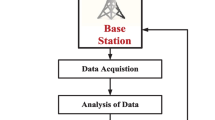Abstract
Sensor nodes deployed in a remote location are vulnerable to various attack. An intruder can easily capture and tamper with sensor nodes deployed in a remote location. As a result, intrusion detection is crucial task in the field of wireless sensor network. In this work, we propose an intrusion detection approach for WSN. In our method,we are using Graph Neural Network and Lyapunov optimization. In the training phase, we train graph data using GNN. We are using Lyapunov optimization to adjust weights of the synapses connecting two neurons to an optimum value. Here we used AWID datasets to train and test GNN. Lyapunov optimization is used to compute loss in GNN and adjust weight accordingly to minimize loss. We show test results of our method using performance matrices, namely, Accuracy, Sensitivity, Precision, F1 Score. Comparison with existing work showed that our method gives better detection accuracy.




Similar content being viewed by others
Data Availability
The AWID2 data analyzed during the current study is available upon request in the AWID repository (https://icsdweb.aegean.gr/awid/download-dataset).
References
Elsaid SA, Albatati NS (2020) An optimized collaborative intrusion detection system for wireless sensor networks. Soft Comput:1–15
Gavel S, Raghuvanshi AS, Tiwari S (2020) A novel density estimation based intrusion detection technique with pearson’s divergence for wireless sensor networks. ISA Trans
Gu J, Lu S (2021) An effective intrusion detection approach using svm with naïve bayes feature embedding. Comput Secur 103:102158
Kaja N, Shaout A, Ma D (2019) An intelligent intrusion detection system. Appl Intell 49(9):3235–3247
Kasongo SM, Sun Y (2020) A deep learning method with wrapper based feature extraction for wireless intrusion detection system. Comput Secur 92:101752
Kipf TN, Welling M (2016) Semi-supervised classification with graph convolutional networks. arXiv:1609.02907
Kolias C, Kambourakis G, Stavrou A, Gritzalis S (2015) Intrusion detection in 802.11 networks: empirical evaluation of threats and a public dataset. IEEE Commun Surv & Tutorials 18(1):184–208
Liu Z, Chen C, Yang X, Zhou J, Li X, Song L (2018) Heterogeneous graph neural networks for malicious account detection. In: Proceedings of the 27th ACM international conference on information and knowledge management, pp 2077–2085
Mao Y, Zhang J, Letaief KB (2015) A lyapunov optimization approach for green cellular networks with hybrid energy supplies. IEEE J Sel Areas Commun 33(12):2463–2477
Neely MJ (2010) Stochastic network optimization with application to communication and queueing systems. Synth Lect Commun Netw 3(1):1–211
Rahman MA, Taufiq Asyhari A, Wen OW, Ajra H, Ahmed Y, Anwar F (2021) Effective combining of feature selection techniques for machine learning-enabled iot intrusion detection. Multimed Tools Appl:1–19
Safaldin M, Otair M, Abualigah L (2020) Improved binary gray wolf optimizer and svm for intrusion detection system in wireless sensor networks. J Ambient Intell Humanized Comput:1–18
Saravana Kumar NM, Deepa S, Marimuthu CN, Eswari T, Lavanya S (2016) Signature based vulnerability detection over wireless sensor network for reliable data transmission. Wirel Pers Commun 87(2):431–442
Shukla AK (2020) Detection of anomaly intrusion utilizing self-adaptive grasshopper optimization algorithm. Neural Comput & Applic:1–21
Wang Y, Sun Y, Liu Z, Sarma SE, Bronstein MM, Solomon JM (2019) Dynamic graph cnn for learning on point clouds. Acm Trans on Graphics (tog) 38(5):1–12
Wazid M, Das AK (2016) An efficient hybrid anomaly detection scheme using k-means clustering for wireless sensor networks. Wirel Pers Commun 90 (4):1971–2000
Yang S, Gao T, Wang J, Deng B, Lansdell B, Linares-Barranco B (2021) Efficient spike-driven learning with dendritic event-based processing. Front Neurosci 15:601109
Yang S, Wang J, Deng B, Azghadi MR, Linares-Barranco B (2021) Neuromorphic context-dependent learning framework with fault-tolerant spike routing. IEEE Trans Neural Netw Learn Syst
Ying R, He R, Chen K, Eksombatchai P, Hamilton WL, Leskovec J (2018) Graph convolutional neural networks for web-scale recommender systems. In: Proceedings of the 24th ACM SIGKDD international conference on knowledge discovery & data mining, pp 974–983
You J, Bowen L, Rex Y, Pande V, Leskovec J (2018) Graph convolutional policy network for goal-directed molecular graph generation. arXiv:1806.02473
Yu H, Neely MJ (2018) A new backpressure algorithm for joint rate control and routing with vanishing utility optimality gaps and finite queue lengths. IEEE/ACM Trans Networking 26(4):1605–1618
Zheng L, Cai L (2014) A distributed demand response control strategy using lyapunov optimization. IEEE Trans Smart Grid 5(4):2075–2083
Zhou Y, Cheng G, Jiang S, Dai M (2020) Building an efficient intrusion detection system based on feature selection and ensemble classifier. Comput Netw 174:107247
Zitnik M, Leskovec J (2017) Predicting multicellular function through multi-layer tissue networks. Bioinforma 33(14):i190–i198
Author information
Authors and Affiliations
Corresponding author
Ethics declarations
Conflict of Interests
On behalf of all authors, the corresponding author states that there is no conflict of interest.
Additional information
Publisher’s note
Springer Nature remains neutral with regard to jurisdictional claims in published maps and institutional affiliations.
Rights and permissions
Springer Nature or its licensor holds exclusive rights to this article under a publishing agreement with the author(s) or other rightsholder(s); author self-archiving of the accepted manuscript version of this article is solely governed by the terms of such publishing agreement and applicable law.
About this article
Cite this article
Biswas, P., Samanta, T. & Sanyal, J. Intrusion detection using graph neural network and Lyapunov optimization in wireless sensor network. Multimed Tools Appl 82, 14123–14134 (2023). https://doi.org/10.1007/s11042-022-13992-9
Received:
Revised:
Accepted:
Published:
Issue Date:
DOI: https://doi.org/10.1007/s11042-022-13992-9




